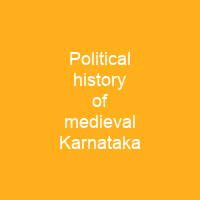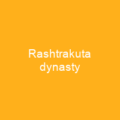The political history of medieval Karnataka spans the 4th to the 16th centuries. The rise to power of the Kadamba Dynasty of Banavasi identified the Karnataka region as an independent political entity. The fall of the Vijayanagara Empire in 1565 brought about a slow disintegration of Kannada-speaking regions into minor kingdoms.
About Political history of medieval Karnataka in brief
 The political history of medieval Karnataka spans the 4th to the 16th centuries. Before this, alien empires held sway over the region, and the nucleus of power was outside modern Karnataka. The rise to power of the Kadamba Dynasty of Banavasi identified the Karnataka region as an independent political entity. The fall of the Vijayanagara Empire in 1565 brought about a slow disintegration of Kannada-speaking regions into minor kingdoms that struggled to maintain autonomy in an age dominated by foreigners until unification and independence in 1947. The medieval era can be broadly divided into several periods: The earliest native kingdoms and imperialism; the successful domination of the Gangetic plains in northern India and rivalry with the empires of Tamilakam over the Vengi region; and the domination of southern Deccan and consolidation against Muslim invasion. The origins of the rise of the Karn Bangalore region as a independent power date back to the fourth-century birth of the Kadamba Dynasty. The Kadambas were the earliest of the native rulers to conduct administration in the native language ofKannada in addition to the official Sanskrit. They were followed by the imperial dynasties of the Badami Chalukya Empire, the Rashtrakuta Empire and the Hoysala Empire, all patronising the ancient Indic religions while showing tolerance to the new cultures arriving from the west of the subcontinent. The hereditary ruling families and clans ably served the large empires and upheld the local culture and traditions.
The political history of medieval Karnataka spans the 4th to the 16th centuries. Before this, alien empires held sway over the region, and the nucleus of power was outside modern Karnataka. The rise to power of the Kadamba Dynasty of Banavasi identified the Karnataka region as an independent political entity. The fall of the Vijayanagara Empire in 1565 brought about a slow disintegration of Kannada-speaking regions into minor kingdoms that struggled to maintain autonomy in an age dominated by foreigners until unification and independence in 1947. The medieval era can be broadly divided into several periods: The earliest native kingdoms and imperialism; the successful domination of the Gangetic plains in northern India and rivalry with the empires of Tamilakam over the Vengi region; and the domination of southern Deccan and consolidation against Muslim invasion. The origins of the rise of the Karn Bangalore region as a independent power date back to the fourth-century birth of the Kadamba Dynasty. The Kadambas were the earliest of the native rulers to conduct administration in the native language ofKannada in addition to the official Sanskrit. They were followed by the imperial dynasties of the Badami Chalukya Empire, the Rashtrakuta Empire and the Hoysala Empire, all patronising the ancient Indic religions while showing tolerance to the new cultures arriving from the west of the subcontinent. The hereditary ruling families and clans ably served the large empires and upheld the local culture and traditions.
Some historians view them as the originators of Karnataka tradition, although there were elements in common with the architectural structures of the Pallavas built by the last Kadamba ruler Krishna Iarma II in the 6th century when he was subdued by Pulakeshin Iarma. The dynasty would continue to rule parts of Goa and Karnataka for many centuries but never come again as independent as they did in the last century of the 19th century. The fact that the Kadamba cultivated marital ties with the imperial Vakatakas and Gupta dynasty attests to their power. The rule of the Bahamani Sultanate of Bidar and the Bijapur Sultanate caused a mingling of the ancient Hindu traditions with the nascent Islamic culture in the region. With the weakening of the Satavahanas, the Pallvas of Kanchi took control for a brief duration. The Muslim invasion of the deccan resulted in the breaking away of the feudatory Sultanates in the 14th century and the formation of the Kancheya dynasty in the 15th century, but the region remained under the control of the Gupta dynasty until the early 20th Century. The region was ruled by such imperial powers as the Mauryas of Maghada and later the Satvahanas. It was also ruled by the Sativahanas and the Rashtras, whose centres of power were in the Gangetics plains and Central India respectively. In the early centuries of the first millennium, large areas of the Bangalore region were ruled by Such imperial powers.
You want to know more about Political history of medieval Karnataka?
This page is based on the article Political history of medieval Karnataka published in Wikipedia (as of Nov. 04, 2020) and was automatically summarized using artificial intelligence.







